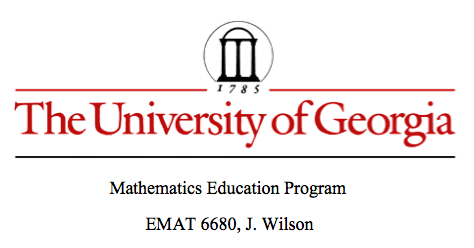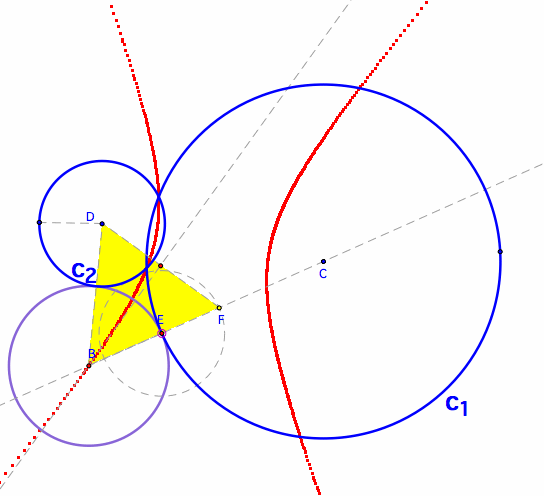

Teaching Tangents
by
Patty Wagner
Many students have already heard the word "tangent" and have a rough idea of what it means. The following activity is designed to stretch your students' understanding of this concept by applying it to the realm of circles. They will also get some practice in recalling basic properties of ellipses and hyperbolas.
Lesson Outline
- discuss concept of tangent and apply it to circles
- guide students through the process of creating a circle that is tangent to two circles
- consider the locus of the center of the tangential circle and establish properties for different positions of the beginning circles
- allow students to construct the second type of tangential circle, predict the path of its center for the different beginning positions of the defining circles, and test their prediction
You may like to begin the lesson by discussing the meaning of the word tangent and how it varies according to context. What does it mean to "go off on a tangent" in a discussion? You can help your students develop conceptual imagery of tangent by modeling this idea. Think of a discussion as a circle in which logical and productive flow will produce movement along the circle.
For example, you and your friends are discussing where to go out to eat. The conversation is productive, with everyone sharing what they know about what is nearby, etc. When someone mentions "Zaxbys," Ken begins to tell the group a story about the last time he ate there. Ken has just taken the conversation off on a tangent. Using a picture similar to the one on the left, you can point out that the tangent "touched on" the discussion but took it off the intended path. In fact, tangents are related to the "discussion" in a perpendicular manner.
Ask your students questions, such as "Is that point on the circle the only point that has a tangent?" and "Which points on the circle have a tangent associated with it?" to lead your students to the conclusion that every point on the circle has an associated tangent and this tangent is always perpendicular to the line passing through that point and the center of the circle.
Your students should now be able to consider the idea of a tangential circle. Given the two circles at right, is it possible to construct a third circle that is tangent to the outer circle at the red point, E?
At this point you want to have your students consider how many possible circles can be constructed that will be tangent to both circles at the point. (There are two.)
One example is at left. (We will reserve the other example for students to explore at the end of the lesson.)
How can we construct this tangential circle? Click here for a very good demonstration of the construction with a conceptual explanation of each step.
Now that you and your students have worked through the construction, it's time to consider the locus of the center of the tangential circle. There are three possible situations that we should consider:
Case 1: One circle is fully inside the other.
In this case the locus appears to be an ellipse.
Case 2: The circles intersect.
This case also seems to produce an ellipse.
Case 3: The circles do not intersect and one is not inside the other.
The locus appears to be a hyperbola.
The challenge for your students at this point is to determine if each of the familiar looking shapes are indeed what they appear.
In case 1, it appears that the locus is an ellipse with the foci being the centers of our two original circles, namely point D and point C. We know that if this is true, then BD + CB will be constant.
Consider that CF is constant (since it's equal to the radius of circle 1 + the radius of circle 2). Also, notice that CF = CB + BF. Recall, however, that in our original construction, triangle BDF is an isosceles triangle with BF = BD. Therefore, we can say that CF = CB + BD, which is constant.
If you now direct your students' attention to the image for case 2, you can argue that the same reasoning proves that the locus in that case is also an ellipse.
So, at what point will the locus no longer produce an ellipse? Case 3 clearly does not produce an ellipse and closer examination reveals the reason. Now point C is on the other side of point B. Is the shape of the locus a hyperbola? If so, then DB - BC will be constant.
Notice that BF = BC + CF; but the measure of CF is constant, so we can say BF - BC is constant. Since BF = DB, we have DB - BC is constant which is what we needed to show.
At what exact point will the locus transition from an ellipse to a hyperbola?
- We know that we have an ellipse when DB + BC = constant.
- We know that we have a hyperbola when DB - BC = constant.
- What if point B = point C?
If point B = point C, then BC = 0 and we have the following:
Let point H lie on circle 1. Does it also lie on circle 2? If so, we know that circle 1 and circle 2 intersect at point H.
We know that CE = CH and since point B = point C, that BE = BH. Since BF = BD, then DH must equal EF. We know from our construction that EF is equal to the radius of circle 2. So point H must lie on circle 2.
Therefore, when the two circles intersect at a single point, we have a constant value for BD and the locus is in transition between ellipse and hyperbola. In fact the locus is a single point, B.
Now it is time for your students to explore these ideas on their own. Early in the lesson, students realized that there were two different types of tangential circles they could construct. Now they can try to construct the other one that looks like this:
Your students should find that in this case BF = BD. Notice that now CF = CB + BF + FE and that CF and FE are constants. So in this case, CB + BF = CF - FE which is a constant. Students should expect that the locus will produce an ellipse in this case. Once they have made this prediction, have them test it:
Next, students should predict that when B = C, BE = BE + the radius of circle 2. This will happen when circle 2 intersects circle 1 at a single point in which circle 2 is still inside circle 1. Moving the circle further outside will produce an intersection at two points and in this case, the locus will form a hyperbola as will be the case when circle 2 is moved completely outside circle 1.

Return to Patty Wagner's home page